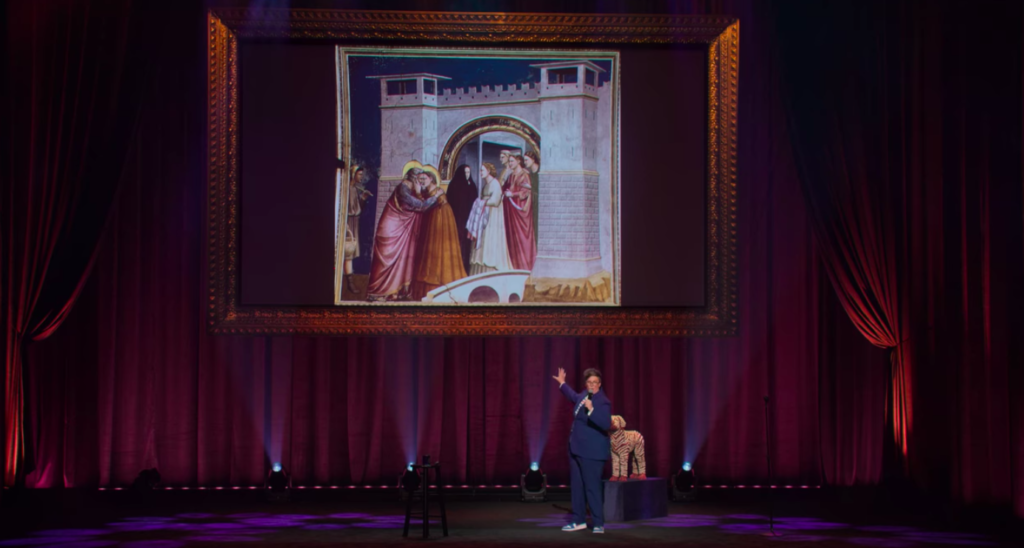Art World
Comedian Hannah Gadsby Offers a Hilarious Art History Slide Show in Her New Netflix Special. We Decode the References Here
Gadsby's knack for using art history to understand her own emotions is funny, but it's also useful.

Gadsby's knack for using art history to understand her own emotions is funny, but it's also useful.

Caroline Goldstein

The comedian Hannah Gadsby opens her new Netflix special, Douglas, by setting expectations low for her first major project after last year’s earth-shattering, boundary-busting Nanette. Gadsby knows she’s got a tough act to follow, and instead of attempting another gut-wrenching blow-by-blow of her personal trauma (which, she notes, she’s fresh out of), she proceeds to give viewers something they did not know they needed: a contemporary feminist analysis of art history.
The former art history major embraces exactly what her critics accused her of doing in Nanette: turning the comedy special form into a lecture. “You want a lecture?” she asks. “I’ll give you a fucking lecture.” And so she does, like only an art history major can.
Below, we break down the best art historical references in Gadbsy’s new special. Cue the slides.

Still from “Hannah Gadsby: Douglas” on Netflix, 2020.
Gadsby begins with a series of rapid-fire images that anyone who has taken an introduction to art history course is familiar with: Michelangelo’s The Creation of Adam, Raphael’s The School of Athens… sensing a theme here? Why, yes, these are artists of the Renaissance, and, yes, they are also the names of the Teenage Mutant Ninja Turtles!
The sewer-dwelling gang is something of a bugbear for Gadsby, and rightfully so, as she explains that they are not, in fact, turtles, but tortoises. And, for that matter, if you’re going to name a group of turtles after Renaissance masters, why not check on your historical accuracy?
Gadsby is right: the High Renaissance, she reminds us, took place between 1500 and 1520 (though some scholars argue that it began in 1490), a time when Michelangelo, Raphael, and Leonardo were at the height of their careers, painting masterpieces left and right. But where is the final member of the quartet, Donatello? Plot twist: he died in 1465.
“He does not belong in their street gang,” she says, noting that if we’re going to teach young kids with a nod to artistic continuity, the least we could do is fact check.
Gadsby distills Raphael’s famous fresco The School of Athens (1509–11) as an illustration of “all the men who named all of the things,” highlighting in particular the presence of Pythagoras (who named all the triangles). If you, like Gadsby, are wondering what all of the women were doing while the men were naming things, the answer, according to her read of art history, is “standing around in groups of three, naked, waiting for men.”
For evidence, look no further than these depictions of undressed trios: Raphael’s The Three Graces (1504–5); Charles-André van Loo’s The Three Graces (1763); Jan Brueghel the Younger and Frans Wouters’s Three Graces With a Basket of Flowers (1635); and Peter Paul Rubens’s The Three Graces (1630–35). “Dancing naked in groups of three in the forest is the number one hobby of women of all time,” Gadsby says.
She calls particular attention to Rubens’s take on the Graces, since she notes some tension in the embrace of the two women on the left, likely caused by the presence of a certain gauzy fabric in an uncomfortable spot.

Peter Paul Rubens, The Three Graces (1630–35). Courtesy of Wikimedia Commons.
“It’s worth pointing out at this juncture that this is not an accidental photograph,” she points out. “What this is is a painting, which makes this”—she points to the central figure’s rear—”a decision, a decision that a man made and spent time on.”
Toward the end of the special, Gadsby returns to the art history lecture format to revisit a few other sexist tropes, including, in her words, the second most popular hobby among women (other than gathering naked in groups of three): being chained to rocks.

Various versions of Andromeda chained to a rock by Annibale Carracci and Domenichino, (1597); Rembrandt (ca. 1630); Rodin (1887); and Giorgio Vasari, (1570–75). Courtesy Wikimedia Commons.
She also points out art history’s many scenes of men enjoying showers of breast milk…

Left, Master I.A.M. van Zwolle’s The Lactation of St. Bernard (1470–85) and Alonso Cano’s St. Bernard and the Virgin (1645–52). Courtesy of Wikimedia Commons.
…and of course, the all-time classic: nude women frolicking amongst a bevy of fully suited men.

Gustav Courbet’s The Painter’s Studio (1855), featuring a nude woman amongst a room full of clothed men. Courtesy Wikimedia Commons.
The broader special revolves around the impact Gadsby’s recent autism diagnosis has had on her ability to see her own life experiences—and the unorthodox way she thinks—through a new lens. For her, having autism is a lot like being the only sober person at a party full of drunks and feeling perpetually out of place—much like the black-swathed woman depicted in Giotto’s The Meeting at the Golden Gate (1304–6), who pulls up her cloak in discomfort in the face of serious PDA.
Despite a few “gimme” jokes that poke fun at the gigantic babies that predated any real understanding of perspective and the prevalence of disembodied genitals that pepper art history, the takeaway from Gadsby’s sophomore special is that even when that history seemingly has no bearing on the present day, understanding how stereotypes and beauty ideals have persisted over the centuries does, in fact, have merit—and for Gadsby at least, the ability to see art differently has formed the foundation of a pretty special career.